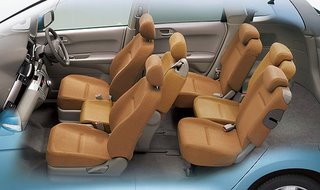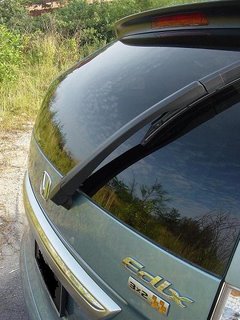
I have sometimes wondered about our collective fixation with certain magic numbers, such as the golden ratio for ‘A’-sized paper, or on a less logical level, the number 13. Even when it comes to cars, it seems that this same inclination prevails. Take, for example, our tendency to think in terms of five- or seven-seaters. For regular cars, five seems to be the default choice. But throw any number of children into the mix, and Family Man starts to panic and think in terms of MPVs, which in this day and age usually means seven seats, in a two-three-two formation.
Now, when was the last time you saw two adults and five children in an MPV? Or two parents, a maid and four kids? How many families here even have four kids? Not many, judging from the looks of astonishment I get when I tell them that we’re expecting our third. So why the fascination with seven seats, especially with the obvious drawback of having to settle for either passenger or boot space? If I needed to transport seven humans, I’d want space for their things too.
Short of going mega-size a-la the Americano Grand Voyager, some lateral thinking was needed to address the seemingly-contradictory needs. Well, that’s exactly what Fiat did (quite literally) with the Multipla in 1999. Its novel three-plus-three seating arrangement allowed for six adults plus a decent boot. The compromise was that it was as wide as the new S-Class, but I guess one could excuse its girth. What was inexcusable, and the main reason for its sales failure, was its looks. It has been called lots of names, many of them amphibian-related, and almost none complimentary. A 2002 facelift failed to redress the situation, and instead actually rendered it boring. Still, the basic concept worked, so who could turn things to their advantage?
As usual, it would be the Japanese, who have a habit of churning out copies that surpass their originals. But surprisingly, the Multipla wasn’t the inspiration – an American car was. Honda’s Masaaki Tsunoda took his two kids for a ride in an old Cadillac, and thoroughly enjoyed the way all three could sit out in front. And in their press releases, Honda continually stress the importance that family communication played in the design of the car. In typical Japanese fashion, the car’s name was an amalgamation of two words that describe its nature: Edit Six – flexibility for six occupants.

Like the Multipla, the Edix (or FR-V, as it is called in Europe) features two rows of three seats, allowing six people and their luggage to fit, while keeping the body length down. At the same time, it manages to avoid being excessively wide. At 1810mm, it has exactly the same exterior width as the Renault Scenic, which in turn happens to be 61mm less than the Multipla. Still, it is 110mm wider than the Civic whose chassis it shares, and not many manufacturers have the know-how to make such extensive adjustments to a single platform. This could go some way to explaining the dearth of other similarly-configured competitors.
Styling-wise, the Edix steers clear from the bread van template of most MPVs, without succumbing to the Multipla’s willful wackiness. Its wedgy profile is accentuated by a rising waistline, which in combination with the wide stance, tight wheel arches and steeply raked rear windscreen makes for a distinctively sporty shape, by class standards.

This tapered profile stands in contrast to the flat and almost upright side windows, necessary to liberate the maximum amount of interior room. As a result, the Edix looks its oddest and squarest head-on, especially with the relatively narrow 15” wheels that come standard. Fortunately, the bodywork itself is interesting enough to break the large expanses of sheet metal. Convex and concave surfaces interact with sharp creases in a way that visually guides the eye to see the fundamental form – I know that description sounds suspiciously like Bangle-speak, but trust me, here the end result works.
Of course, Honda saved most of its ingenuity for the interior. The six independent seats – each with their own three-point seat belt - can be folded and slid in a multitude of combinations with an ease that the firm has become known for. The front middle, in particular, is especially interesting. In addition to being able to slide back an impressive 270mm, it folds flat forward to act as an armrest cum table top, has a split squab that folds out to reveal a tray, and features a pull-put drawer underneath. As the Dark Lord himself would have commented: “Impressive”.

Taking the cue from the Jazz/Fit, the three rear seats also fold into the floor with just a single pull of a catch. No arduous removal or even tumble fold required. The rear middle can move back 170mm, like the seat in front, to improve leg and shoulder room. So with six on board, you can expect the seats to be arranged in a double-vee configuration.
In all of this, the boot remains usable – 439 litres (larger than a Corolla’s, by the way) available with six occupants, expanding to a gargantuan 1049 litres with three passengers. More than anything else, it was this factor that convinced us of the Edix’s value. In a little over a month’s time, our traveling family will consist of two parents, three children in their space-consuming seats, as well as a maid. Throw in a stroller, groceries, swimming things and other barang, and it becomes obvious why a ‘normal’ three-rowed MPV wouldn’t do.

Oh, and then there’s my fear of getting rear-ended. Anyone who’s seen a fairly serious accident will know that the boot can crumple all the way to the rear wheels. Which is fine for normal sedans because the passenger compartment is left intact. But the last row of a seven-seater resides in the boot itself, so you can imagine the consequence of a hit from behind.
We have also discovered some unexpected benefits to having two rows of seats instead of three, besides having all the kids within smacking range. For one, the aircon reaches the passengers more quickly without the need for piping vents to the rear. The middle vents have a split function, which directs air towards the front occupants as well as over their heads to the back. A dial allows you to control how much of it goes where – clever.
Moreover, parking is surprisingly stress-free, as the Edix is some 97mm shorter than my previous Focus sedan, despite boasting a 65mm longer wheelbase. And another thing – as the turning radius is compact-car small at 4.9m, U-turns can be taken with disdain. There’s just the extra width to contend with, so some extra convex mirrors can come in handy!
Dynamically, it’s no Focus though. Inheriting the ES Civic’s platform also meant getting slightly under-damped suspension, which takes a while to settle after running over a speed hump. The springs are a little soft, and the steering a tad light, which should be expected from an MPV. But the Mazda 5 shows what can be achieved, given a decent chassis. Well weighted steering and fine body control contribute to a drive that puts many sedans to shame. Although the Edix resists roll well in corners, it doesn’t show quite the same poise. After a while you realise that the limits of the car are actually quite high, they just aren’t very well spelt out. And ultimately, that extra precision makes the difference in the amount of confidence you have in the machine when you’re really going for it.
However I can’t complain about the engine. Sure, the D17A is old school as far as Honda units are concerned, but 125bhp from 1.7 litres is hardly a disgrace by any standard. And it revs cleanly through its almost linear power band, allowing you to fully exploit its potential. Too many engines I’ve come across have decent on-paper specs, only to come across so gruff and boomy that you’re not really interested to use it, rendering the exercise redundant.

Coupled to the motor is a simple but effective four-speed automatic gearbox. No, it doesn’t offer Tiptronic-style shifts, but the gear changes are jerk-free to the extent that only indications you are likely to notice are the dip of the engine note and tachometer needle. Still, my left hand and leg are starting to feel atrophied from non-use. At times I’ve even been tempted to step on the foot-activated parking brake just to get some exercise! Give me a stick and clutch any day, especially one of Honda’s noted slick shifters, and I’ll be over the moon.
Which is not to say that I’m unhappy. Quite the opposite, in fact – the Edix seems almost tailor-made for a family with our circumstances. The cabin is wide enough to take three child seats abreast; the brilliant seats are flexible to handle just about any configuration we can throw at them; the boot is well shaped and sized; and the engine revvy and frugal at the same time. Oh, and for the $67k we paid, it’s also a veritable steal. If perfection ever existed, it would be endowed with that manual gearbox, plus the Mazda 5’s chassis, steering and sliding doors. But nature has a way of saying you can’t have it all, and I’m just glad I don’t have to face an amphibian at the car park everyday.

